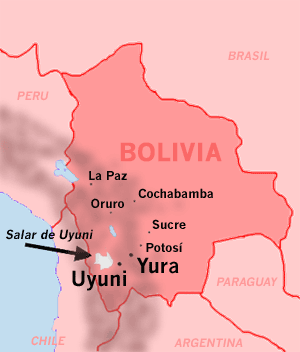It is estimated that plates move on average, approximately 2.5 cm per year. Calculations were made with this statistic in mind. The focus of these predictions lies in the eastward movement of the oceanic Nazca plate and the westward movement of the South American Plate.
| Plate Movements near the Salar de Uyuni |
10, 000 years from today...
The Salar is a high altitude desert and because of its location in the Andes Mountains, eventually more convergence will occur as the ocean plate subducts under the continental plate In 10, 000 years the plate will move approximately 25,000 cm or 250 meters. This converts to about 0.16 miles. This is not a considerable distance and will not do much to alter the landscape of the Salar.
The geography will change due to other factors. For one, the salt in the Salar will be long gone by then. Approximately 25, 000 tons of salt are harvested annually and it is estimated that within 50 years from today the salt flats will be mined to the point of extinction. With no salt, the closed draining basin will eventually return to a small lake, as it was about 11,000 years ago, although this time freshwater versus saltwater. As climate changes becomes more localized, the Salar will experience heavier rainfalls and more drastic droughts.
1, 000, 000 years form today...
In 1,000,000 years the plate will have moved 15.53 miles. For perspective, this is the distance from Denver to Golden, Colorado. As the Nazca oceanic plate continues to converge with the South American continental plate, the closed-draining basin of the Salar will become an open draining basin. Once this occurs, the lake will slowly recede and eventually become a marshier river area and vegetation will increase. It will look much like the other parts of the Altiplano:
100, 000, 000 years from today...
The Nazca plate will continue on its journey moving east, towards the South American continent. 100,000,000 years from today it will have approximately moved 1,553.43 miles. For perspective this is a little more than the approximate distance from Denver to Pittsburgh. This movement will create volcanos in the Salar, as the subducting oceanic crust melts and becomes magma.
Overview
The Salar will undergo a series of transformations in the next 100,000,000 years due to plate movement. The salt that characterizes the Salar will disappear very early in this timeline. The Salar will then become a freshwater lake. Another thousand years later it will go from a closed draining basin to an open draining basin. Volcanos will then appear as oceanic crusts further subducts under the continental crust. Finally, this once high altitude desert will become a coastal environment as it moves closer to the ocean.
Sources:
- http://www.smithsonianmag.com/arts-culture/a-tasting-tour-of-salts-around-the-world-87988067/?no-ist
- http://articles.latimes.com/1991-07-07/news/mn-2947_1_salt-flats
- http://www.bbc.com/news/magazine-26993915
- http://www.counterpunch.org/2012/10/22/bolivia-life-at-the-extreme-edge-of-climate-change/
Images:
- http://static.squarespace.com/static/51bbeba5e4b0510af19f26f7/t/51e5be4ae4b094b5d72d9670/1374010955733/NazcaSAmerica.jpg
- http://static.panoramio.com/photos/large/18941473.jpg
- http://quake.eas.gatech.edu/Exercises/PlateTectAct_files/image004.jpg









